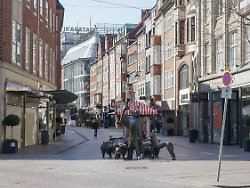Wednesday, March 03, 2021
What happens to the savings?
Corona trillions raise hopes of a buying boom
By Diana Dittmer
In the Corona year, consumers in the world's largest economies saved three trillion dollars – more than ever before. How loose will the money be when the economy reopens? A lot depends on it for further development.
Freedom of movement restricted, shops closed, plus the uncertainty as to whether we will ever cope with this crisis: In the past Corona year, consumers worldwide had a lot of reason to hoard and hoard – that also applied to money. Households in the USA, China, Japan, Great Britain and the largest countries in the euro area – Germany, France, Italy and Spain – have saved a total of almost three trillion US dollars during this time, according to calculations by the US finance agency Bloomberg. Not because they wanted to, but because they were forced to save.
Economists and politicians are now placing their hopes on this gigantic mountain of savings. If the pandemic is brought under control, the massive consumption backlog should dissolve as quickly as possible and money should become a growth driver. That would be the preferred scenario. Whether this will actually happen, whether the crisis will end without harm to the economy, cannot be predicted with one hundred percent certainty. There are arguments for and arguments against.
"Dissolving the consumption congestion is crucial"
Consumers in the USA have put half of the gigantic mountain of money on the high edge: unimaginable 1.5 trillion US dollars, roughly as much as South Korea's gross domestic product in 2019 and more than Spain generated in the same year. In theory, consumers could use their savings to trigger the post-corona boom. If Americans were to get their money out from under their mattresses this year, for example, or carry it from the bank to the shopping malls, economic growth would rise to 9 percent, according to Bloomberg. So far, the experts have forecast 4.6 percent growth. If the money were not spent at all, GDP would only increase by 2.2 percent.
Despite the failure to ramp up the economy last year, optimism reigns: "Summer 2020 turned out to be a false dawn, but it also showed how quickly economies can recover," said Bloomberg euro area economist Maeva Cousin. The chances for 2021 are good that the "massive money buffer from the savings of private households" will dissolve and "demand will recover strongly".
In Germany, according to Bloomberg data, around 142 billion euros have landed on the high edge. The experts at Deutsche Bank are more cautious in their forecast here. "The resolution of the consumption congestion will be decisive for the economic recovery," the analysts point out. In a baseline scenario, they estimate that around 30 percent of savings this year will flow back into consumption. Almost 70 percent, on the other hand, would remain in deposits or assets. If, according to a more optimistic scenario, 40 percent of the savings were spent this year, then this would mean half a percentage point of growth for German GDP in 2021.
Is saving the new normal?
The economy would not make big leaps with it. So the big question remains: will consumers loosen up faster or slower? Do you return quickly to your old shopping routine from pre-Corona times or will it be that you don't trust the peace and prefer to hold back your money a little longer. Much depends on this for further economic development.
If people remain cautious, this could prolong the weak phase of the economy by years. Disasters like the pandemic change people and their behavior. In the face of ongoing uncertainties – the virus will not be eradicated and the labor market may remain tense – people might prefer security and hold their money back for bad times or use it to pay off their debts.
Tax increases, which some fear because of the expensive economic stimulus programs, could also fall into the balance when making a consumption decision and encourage consumers not to spend their money with full hands, as economists would like. In this case, too, the large post-corona booster would not be available. Or at least keep it a long time coming.
Inflation and zero interest rates could fuel the desire to buy
On the other hand, there are also good reasons why the money cushion could shrink quickly. One is likely to be the low interest rates of the central banks. Hoarding money is not worth it. The devaluation of money could also stimulate consumption. Inflation jumped significantly at the turn of the year. What this means in the longer term is still unclear: the price hikes could be a temporary feature of a post-pandemic economic recovery or the beginning of prolonged inflation. Central bankers and investors are currently still trying to get an idea of the situation. Spending more money for an impulse might be enough.
Corona is an outlier. Typically, savings rates follow long-term trends. In other words, savings behavior rarely changes abruptly, wrote Henrik Müller in "Manager Magazin" in December. In their scenario, the economic wise men assumed that the German savings rate would fall back to its pre-crisis level in the second half of 2021 – i.e. more quickly. The rate is currently well over 16 percent. What could speak against it, however, is that at the same time 43 percent of the people in the survey by the German Council of Economic Experts stated that they would continue to save more because of the uncertain economic prospects.
Fears change people's behavior. Nobody knows if the vaccination campaign will be successful. And even if you do, how long will it take to process the corona shock in your mind? The psychological factor is difficult to assess. "In the short term, a lot depends on post-pandemic behavior – it could take time to return to pre-pandemic norms," says Bloomberg economist Yelena Shulyatyeva.
.
